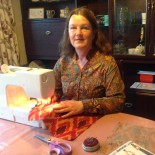One sheep
I came across Angela at the Compton Verney Textile Fair in November. Seeing her beautifully soft, pure sheep’s wool rugs, my immediate question was, “Can i make one of them?” To which the answer was , “Yes”.
So one cold January morning i set off to her farm in mid Leicestershire. Well wrapped up – me that is, not the farm.
We were about to do peg weaving.
However complicated a weaving loom may be, i broadly understand how it is used. I was very puzzled as to how weaving around pegs was going to work!
You begin by cutting your lengths of warp threads, passing them through the pegs, and securing them to the board at the other end of the ‘loom’. Unlike ‘normal’ looms, where warping can be quite scary, warping the peg loom was relatively quick and straightforward. Although i was concentrating so hard that it didnt occur to me to get my camera out at this stage!
It was the weft weaving that was the puzzle.
Beside me was a large box containing the washed fleece from one of the farm’s Cotswold sheep. It had been gently hand washed with water and washing up liquid. If it is over handled whilst wet, it will start to felt, and we dont want that. The same washing technique will apply when / if i chose to wash the finished product. There were patches, especially round the neck, where there were still the remains of straw and hedgerows. I had to select my wool from around the sections that very much confirmed that this had once been part of a live animal!

I ripped away lengths of clean wool, and then gently stretched and twisted it so that i had a piece maybe up to a metre long, and 2 – 3 cm wide, that i could wind in and out of the pegs. Then i twisted in another length, and another, until i had built up woven wool around the height of the pegs. Luckily i remembered to get my camera out round about this stage, although i was not at all sure what was going to happen next……..

One by one, the pegs are lifted out of their wool wrapping, and replaced ’empty’ into the hole. The woven wool slides down the warp threads, and you have the beginnings of a rug!
Then you select more wool and start winding it round the pegs again. Until the pegs are full, when you lift them out of the wound wool again, and slide more rug down the warp threads.
I repeated this process seven times, eventually creating a rug that is about 50 x 55 cm, and about 3cm deep.
To finish, you even out the tension by simply pushing and pulling a bit, cut the warp threads at their ends, tie them close to the rug, and thread in the ends. That’s easy to describe, but took about an hour to do.


The resulting rug is soft and cuddly looking, with extra curly bits from the original sheep.
It’s on the bedroom floor at the moment, but could also be used as a bathmat, as the wool is relatively water resistant.
Whilst i feel that the warp is robust, i have slight concerns about the weft, where i perhaps havent twisted a new piece of wool secuely onto the previous section of wool. If i love and care for it, it will last a lot longer than the sheep from which is came!
Angela made a rug at the same time. It’s a bit longer than mine, but otherwise we did the same things at the same time. Here is the scene towards the end of the day; two rugs and the box of sheep’s wool ready for the next session.

It’s a strange way of weaving. I wondered about the mind of the person / people who invented it. Of course the truth is that all forms of weaving are very ancient, including this one. So it was an obvious process to someone, somewhere once upon a time. It doesnt need many specialised tools. It’s highly portable. Peg weaving can be used with thinner fibre, but the thinner the fibre, the more laborious a method it will be.
It suits cleaned fleece very well.






